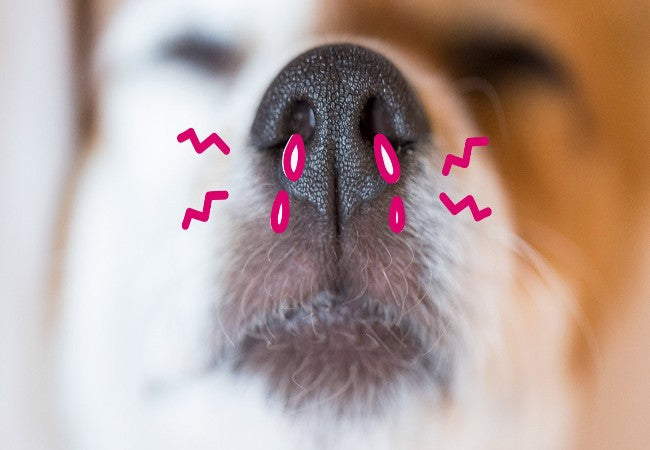Nasopharyngeal Stenosis in Dogs – Vet‑Led Guide 2025 🐶🌬️🩺

In this article
Nasopharyngeal Stenosis in Dogs – Vet‑Led Guide 2025 🐶🌬️🩺
By Dr. Duncan Houston BVSc
Hi, I’m Dr Duncan Houston, BVSc, founder of Ask A Vet. Nasopharyngeal stenosis (NPS) is a narrowing of the airway behind the nose and above the throat. It often results from scar tissue formation and can cause serious breathing challenges. In this expert 2025 guide, we’ll cover origins, symptoms, diagnostics, modern treatments like balloon dilation and stenting, medications, and home care strategies to help your dog breathe easier and live better. Let’s dive in! 🌬️🐾
📘 What Is Nasopharyngeal Stenosis?
NPS is a partial blockage of the nasopharynx (the space behind the nasal passages) caused by a fibrous membrane or tissue scar that narrows airflow. This thin but firm scar may develop after chronic infection, vomiting, gastrointestinal reflux during anesthesia, foreign material, or trauma.
🚩 Causes & Risk Factors
- Chronic upper respiratory infections: lingering inflammation scars tissue.
- Gastric reflux during anesthesia: acid injures back-of-nose mucosa.
- Foreign bodies or irritants: noses exposed to debris, caustics.
- Persistent vomiting or regurgitation: acid injury leads to fibrosis.
🧠 Who Can Be Affected?
Dogs of any age and breed may develop NPS, but those with a history of severe infections or anesthesia with regurgitation are at higher risk. Both dogs and cats can develop this condition.
🚨 Recognizing Clinical Signs
- Whistling/snoring nasal noise, especially on inspiration.
- Open-mouth breathing, wheezing, and labored breathing.
- Nasal or pharyngeal discharge, sometimes blood-tinged.
- Worse while eating or sleeping—a sign of oropharyngeal crowding.
- Poor response to antibiotics or kennel cough treatment.
🔍 How Is It Diagnosed?
- Medical history & exam: notes symptoms like inspiratory noise, discharge, or reflux events.
- Laboratory tests: CBC/chem to rule out infection; usually normal.
- Imaging: CT & X-ray visualize the narrowing; endoscopic guidance confirms the extent.
- Endoscopy/fluoroscopy: fiberoptic camera to see membrane; fluoroscopy guides instruments—used with balloon dilators.
- Dilation trial: balloon dilation confirms patency and therapeutic response.
💊 Treatment Options
1. Balloon Dilation
- Minimally invasive—balloon placed over guidewire under fluoroscopy and inflated to open the stenosis.
- Often requires 2–3 repeat sessions spaced weeks apart to maintain the opening.
- Pros: immediate relief, low risk. Cons: 50% recurrence with dilation alone in dogs, higher in cats.
2. Stents (Metallic/Silicone)
- Placing a temporary or permanent stent stabilizes open airway following dilation.
- Uncovered metallic stents: ~67% success; Covered stents: up to 100% in small studies.
- Risks: tissue ingrowth, infection, oronasal fistulas, migration.
3. Surgical Excision
- Classic surgical removal of the scar membrane—often with high recurrence unless combined with dilation or adjunct therapy.
- Can be combined with other techniques depending on lesion location and severity.
4. Adjunctive Medications
- Antibiotics: post-procedure prophylaxis to prevent infection.
- Steroids: systemic or intralesional to limit scarring—e.g., triamcinolone after dilation.
- Mitomycin-C: topical anti-fibrotic used after dilation or excision to reduce scar recurrence.
🏡 Home & Post‑Op Care
- Keep calm environment to reduce respiratory effort.
- Administer antibiotics and steroids exactly as prescribed.
- Monitor breathing noise, appetite, and nasal discharge.
- Avoid irritants—smoke, aerosol sprays, dust.
- Follow up with endoscopy/CT within 4–6 weeks to check patency.
- Plan for repeat procedures if labored breathing or noises recur.
- Maintain normal weight and hydration to support healing.
📅 Prognosis & Outlook
- Dogs do well with combined dilation and anti-scar therapy; many breathe normally long-term.
- 50–100% initial success with stent placement, though stent-related complications are common.
- Recurrence usually occurs within 4 weeks if post-dilation scars form.
- Cats may have higher relapse; dogs tolerated stents well.
- Repeated interventions and meticulous post-care significantly improve long-term outcomes.
🐾 Ask A Vet
If you suspect breathing difficulty or nasal noise in your dog, connect 24/7 via Ask A Vet. For managing post-op recovery,
✨ Key Takeaways
- Nasopharyngeal stenosis is airway narrowing behind the nose due to scarring.
- Common after infections, regurgitation under anesthesia, or foreign irritation.
- Diagnosed using history, imaging (CT, fluoroscopy), and endoscopy.
- Balloon dilation + stents and anti-scar meds like steroids or MMC give best outcomes.
- Recurrence is common, so repeat procedures and home care are crucial.
- With timely intervention and diligent follow-up, dogs can return to normal breathing comfortably.
- If you notice breathing noises or nasal symptoms, don’t wait. Contact your vet or Ask A Vet. Early treatment leads to better breathing and happier days ahead. 🐾❤️
If your dog shows whistling, snoring, or struggles breathing through the nose—get it checked promptly. NPS is treatable and manageable with proper care. 🩺






